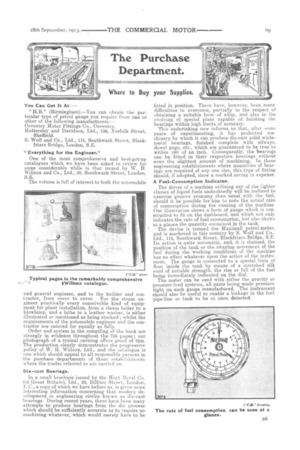h The Purchase
Page 19

If you've noticed an error in this article please click here to report it so we can fix it.
Department.
Where to Buy your Supplies.
You Can Get It At- "H.B." (Birmingham).—You can obtain the particular type of petrol gauge you require from one or other of the following manufacturers : Coventry Motor Fittings Co., Coventry. Hattersley and Davidson, Ltd., 139, Norfolk Street, Sheffield.
S. Wolf and Co., Ltd., 115, Southwark Street, Blackfriars Bridge, London, S.E.
"Everything for the Engineer."
One of the most comprehensive and best-got-up catalogues which we have been asked to review for some considerable while is that issued by W. H. Willcox and Co., Ltd., 38, Southwark Street, London, S. E.
The volume is full of interest to both the automobile and general engineer, and to the builder and contractor, from cover to cover. For the steam engineer practically every conceivable kind of equipment for plant installation, from a steam boiler to a blowlamp, and a lathe to a leather washer, is either illustrated or mentioned as being stocked; whilst the requirements of the automobile engineer and the contractor are catered. for equally as fully. Order and system in the compiling of the book are strongly in evidence throughout the 736 pages ; our photograph of a typical opening offers proof of this. The production clearly demonstrates the progressive policy of W. H. Willcox, Ltd., and the catalogue is one which should appeal to all responsible persons in the purchase departments of those establislInients where the trades referred to are carried on.
Die-east Bearings.
In a small brochure issued by the Hoyt Metal Co. (of Great Britain), Ltd., 26, Billiter Street, London, E.C., a copy of winch we have before us, is given some interesting information concerning that modern development in engineering circles known as die-cast. bearings. During recent years, there have been many attempts to produce bearings from the die process which should be sufficiently accurate as to require no machining whatever, which would merely have to be
fitted in position. There have, however, been many difficulties to overcome, partially in the respect of obtaining a suitable form of alloy, and also in the evolving of special plant capable of finishing the bearings within high limits of accuracy. This undertaking now informs us that, after sonic years of experimenting, it has perfected machinery by which it can produce die-cast solid whitemetal bearings, finished complete with oilways, dowel pegs, etc., which are guaranteed to be true to within .001 of an inch. Consequently, the bearings can be fitted in their respective housings without even the slightest amount of machining. In those engineering establishments where quantities of bearings are required of any one size, this type of fitting should, if adopted, show a marked saving in expense.
A Fuel.-Consumption Indicator.
The driver of a machine utilizing any of the lighter classes of liquid fuels undoubtedly will be inclined to exercise greater economy than usual with the fuel, should it be possible for him to note the actual rate of consumption during the running of the machine. Our illustration shows a form of gauge which is constructed to fit on the dashboard, and which not only indicates the rate of fuel consumption, but also shows at a glance the quantity contained in the tank. The device is termed the Maximall petrol-meter, and is marketed in this country by S. Wolf and Co.,
Ltd., 115, Southwark Street, Blackfriars Bridge, S.E.
Its action is quite automatic, and, it is claimed, the position of the tank or the swaying movement of the fuel during the working conditions of the machine has no effect whatever upon the action of the instrument. The gauge is connected to a special form of float inside the tank by means of a stretched silk cord of suitable strength, the rise or fall of the fuel being immediately indicated on the dial. The meter cau be used with either the gravity or pressure-feed systems, all parts being made pressure tight on each gauge manufactured. The instrument should also be useful to enable a leakage in the fuel pipe-line or tank to be at once detected.






















